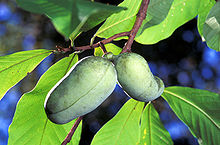| Asimina triloba | |
|---|---|

| |
| In fruit | |
| Scientific classification | |
| Kingdom: | Plantae |
| Clade: | Tracheophytes |
| Clade: | Angiosperms |
| Clade: | Magnoliids |
| Order: | Magnoliales |
| Family: | Annonaceae |
| Genus: | Asimina |
| Species: | A. triloba
|
| Binomial name | |
| Asimina triloba | |

| |
| Natural range | |
Asimina triloba, the American papaw, pawpaw, paw paw, or paw-paw, among many regional names, is a small deciduous tree native to the eastern United States and southern Ontario, Canada, producing a large, yellowish-green to brown fruit.[3][4][5] Asimina is the only temperate genus in the tropical and subtropical flowering plant family Annonaceae, and Asimina triloba has the most northern range of all.[6] Well-known tropical fruits of different genera in family Annonaceae include the custard-apple, cherimoya, sweetsop, ylang-ylang, and soursop.
The pawpaw is a patch-forming (clonal) understory tree of hardwood forests, which is found in well-drained, deep, fertile bottomland and also hilly upland habitat.[7] It has large, simple leaves with drip tips, more characteristic of plants in tropical rainforests than within this species' temperate range.[8] Pawpaw fruits are the largest edible fruit indigenous to the United States[9][10] (not counting squashes, which are typically considered vegetables rather than fruit for culinary purposes, although in botany they are classified as fruit).[3]
Pawpaw fruits are sweet, with a custard-like texture, and a flavor somewhat similar to banana, mango, and pineapple. They are commonly eaten raw, but are also used to make ice cream and baked desserts. However, the bark, leaves, fruit, and seeds contain the potent neurotoxin annonacin.[11]
- ^ "Asimina triloba". The IUCN Red List of Threatened Species. 208. IUCN. e.T135958357A135958359. 2018. doi:10.2305/IUCN.UK.2018-2.RLTS.T135958357A135958359.en. S2CID 242070317.
- ^ "NatureServe Explorer 2.0". explorer.natureserve.org. Retrieved April 27, 2022.
- ^ a b Jones, Snake C.; Layne, Desmond R. (2019). "Pawpaw Description and Nutritional Information". Kentucky State University Cooperative Extension Program. Archived from the original on December 30, 2019. Retrieved December 30, 2019.
- ^ "Asimina triloba". College of Agriculture and Life Sciences, North Carolina State University. Archived from the original on April 6, 2018. Retrieved December 19, 2018.
- ^ Layne, DR (February 24, 1998). "Pawpaw". NewCrop Factsheet, Purdue University. Archived from the original on July 11, 2019. Retrieved December 19, 2018.
- ^ Huang, Hongwen; Layne, Desmond; Kubisiak, Thomas (July 2000). "RAPD Inheritance and Diversity in Pawpaw (Asimina triloba)". Journal of the American Society for Horticultural Science. 125 (4): 454–459. doi:10.21273/JASHS.125.4.454.
- ^ "Native Pawpaw Tree". North Carolina State University. September 6, 2017. Retrieved October 6, 2022.
- ^ Pankau, Ryan (March 28, 2018). "Pawpaw". Illinois Extension Service. University of Illinois Urbana-Champaign. Retrieved October 6, 2022.
- ^ Cite error: The named reference
purduewas invoked but never defined (see the help page). - ^ Matthews, Elizabeth (September 21, 2021). "Pawpaw: Small Tree, Big Impact". U.S. National Park Service. Retrieved December 16, 2021.
- ^ Avalos, J; Rupprecht, J. K.; McLaughlin, J. L.; Rodriguez, E (1993). "Guinea pig maximization test of the bark extract from pawpaw, Asimina triloba (Annonaceae)". Contact Dermatitis. 29 (1): 33–5. doi:10.1111/j.1600-0536.1993.tb04533.x. PMID 8365150. S2CID 41590523.

